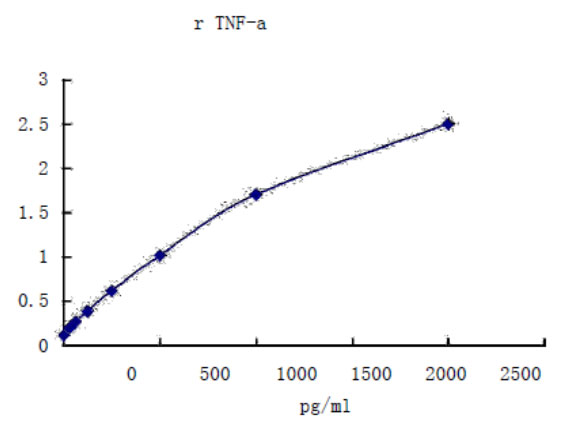Product Detail
Product NameRat TNF-α ELISA kit
ApplicationsELISA
Species ReactivityRt
SpecificityNatural and recombinant Rat TNF-α Ligand
Target NameRat TNF-α
Application Details
Detect Range: 0.03 - 2.0 ng/mL
Sensitivity: 15pg/mL
Sample Type: Cell culture supernatant, serum, plasma (EDTA, citrate, heparin)
Sample Volume: 20 uL
Assay Time: 3 hour
Detection method: Colorimetric
The prototype ligand of theTNFsuperfamily, TNF-α/TNFSF1A, is a pleiotropic cytokine that plays a central role in inflammation and apoptosis (1-4).TNF-α is produced by activated macrophages and other cell types including T and B cells, NK cells, LAK cells, astrocytes, endothelial cells, smooth muscle cells and some tumor cells (5-8).
Rat TNF-α cDNA encodes a 235 amino acid (aa) residue type II membrane protein (9). The 156 aa residue soluble TNF-αis released from the C-terminus of the membrane-anchored TNF-α by TNF-α-converting enzyme (TACE), a matrix metalloprotease (10).
The membrane-anchored form of TNF-α has been shown to have lytic activity and may also have an important role in intercellular communication (11). The biologically active TNF-α has been shown to exist as a trimer (12, 13).TNF-α is reported to promote inflammatory cell infiltration by upregulating leukocyte adhesion molecules on endothelial cells, serve as a chemotactic agent for monocytes, and activate phagocyte killing mechanisms (14). Deficiencies in either TNF-α or its receptors can increase susceptibility to infection by intracellular pathogens (15-16). TNF-α may also play a role in lymphoid tissue development. Knockout mice lack splenic B cell follicles and the ability to form germinal centers (17, 18). Other potential physiological roles for TNF-α and its receptors include regulating the differentiation of hematopoietic stem and progenitor cells (19-21).
If you have published an article using product EK0517, please notify us so that we can cite your literature.
et al,Immune-defensive microspheres promote regeneration of the nucleus pulposus by targeted entrapment of the inflammatory cascade during intervertebral disc degeneration In Bioact Mater on 2024 Mar 20 by Liang Zhou , Feng Cai et al..PMID: 38549774
, (2024),
PMID:
38549774
et al,Myricetin suppresses traumatic brain injury-induced inflammatory response via EGFR/AKT/STAT pathway
, (2023),
PMID:
38123650
et al,Multifunctional manganese-based nanogels catalyze immune energy metabolism to promote bone repair
, (2025),
PMID:
et al,Nature-derived microneedles with metal-polyphenolic networks encapsulation for chronic soft tissue defects repair: Responding and remodeling the regenerative microenvironment.
, (2025),
PMID:
40026624



 YES
YES



